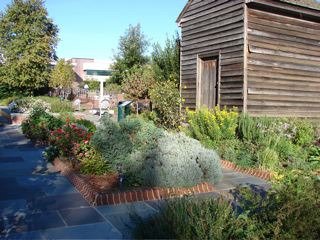- Home
- About Us
- Our History
- 9. Warm Memories, New Dreams
Warm Memories, New Dreams
1994-1995
The community’s response to the Page-Walker exceeded our expectations. The Cary Town Council, Town staff, business and community leaders and the press were amazed at the citizen response to the opening of the first floor of the Page-Walker. It was as though a lake had been discovered in the middle of a desert. During the first three years, thousands of people took part in art shows, performances, lectures and classes. Brides and grooms formed lines at five in the morning to reserve the building for their big event. One of the programs that the Friends initiated continues today: the expansive north lawn just beckoned performances and in 1993, Phyllis Tuttle and Judy Rysdon organized the first annual Starlight Concert Series. It was an instant success with more than 300 citizens enjoying each of the four monthly concerts. For the first several years, performers were paid only with contributions garnered from passing a hat! The Page-Walker was certainly meeting a perceived community need.
 Witnessing the excitement generated by the Page-Walker and related arts and history celebrations, the Cary Town Council led the effort to design a strategic arts program with long-range goals to increase opportunities in arts & history, thus enhancing quality of life in the burgeoning
Witnessing the excitement generated by the Page-Walker and related arts and history celebrations, the Cary Town Council led the effort to design a strategic arts program with long-range goals to increase opportunities in arts & history, thus enhancing quality of life in the burgeoning
As the restoration project drew to a successful completion, we recognized that there was no way that our dreams for the Page-Walker could have been realized without the support and partnership of the Cary Town Council and Town staff throughout the ten-year effort. To salute our partners, the Friends hosted an elegant reception in November 1994 at the Page-Walker for Mayor Koka Booth, Mayor Pro-Tem Regina McLaurin and Council members Bob Godbold, Tom Brooks, Melba Sparrow, Richard Burton and Jack Smith. Town Manager Bill Coleman and Wayne Mingis were also recognized. We thanked them for their tremendous support over the years. The Page-Walker effort is a shining example of the phrase, “It takes a village…”
And finally, it was time for the grand opening to introduce the fully completed and operational
In 1994, the Friends also began working on their “history and education” goals for the Page-Walker. The first thrust was to form a Cary Museum Committee. The Town Council had given permission to use the small west room on the third floor of the Page-Walker for a museum, as the Town was counting on most of the floor space in the center to generate income. Members interviewed several design firms and selected A. Brothers & Associates. Museum Committee members met monthly for five years and were so pleased with the degree of cooperation of Al Brothers and his staff as we developed our plans! Exhibits were constructed to reflect the educational, political, social and economic influences on
In January 1995, a new edition of the book was printed. Tom, with illustrator Jerry Miller, offered the marketing rights for 2900 books and resulting profits to benefit the Museum. Book signings became an invaluable fundraiser. Sheila and Carroll Ogle hosted 500 visitors to their home for a book signing, and Daphne Ashworth continued her support by making the books available at her Hallmark stores. Thanks to Tom and Jerry and our many community friends, we raised the needed funds for the Museum, now called the
To introduce this new treasure in the “attic,” the Friends partnered with the Town’s Cultural Arts Department under the creative expertise of director, Lyman Collins, and Page-Walker supervisor, Sara Maultsby. The dedication of the
 mmersing all in
mmersing all in
The second part of the “history and education” component was the creation of the
In conclusion, I’ve appreciated the invitation by editor Brent Miller to share my memories of the restoration efforts of the Page-Walker. We’ve come a long way from placing a tarp over the roof for water damage control and boarding the first floor windows to prevent further vandalism. And the pigeons have found another place, in another town, to roost. Thanks to the vision and involvement of the Board of the Friends of the Page-Walker Hotel, the active participation of our membership and friends, and the leadership of the Cary Town Council and staff, we can truly feel proud of our accomplishments. As I mentioned in my final article as editor of The Innkeeper in the spring of 1995, I shall always be indebted to the Board for suspending the bylaws for term of office and giving me the honor to be President for the first ten years. As all of us have said through challenging as well as celebration times, the friends we made in reaching our goals are just as much a treasure as the building itself. And so it will be in the future as we continue to be community leaders in preservation, arts, history and education.

